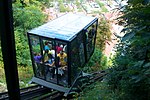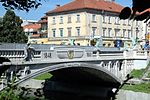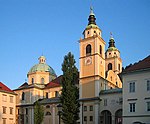City Municipality of Ljubljana
1994 establishments in SloveniaCity Municipality of LjubljanaMunicipalities of SloveniaPopulated places established in 1994

The City Municipality of Ljubljana (pronounced [ljuˈbljaːna]), also the City of Ljubljana (Slovene: Mestna občina Ljubljana, acronym MOL) is one of twelve city and metropolitan municipalities in Slovenia. Its seat is Ljubljana, the largest and capital city of Slovenia. As of December 2021, its mayor is Zoran Janković.
Excerpt from the Wikipedia article City Municipality of Ljubljana (License: CC BY-SA 3.0, Authors, Images).City Municipality of Ljubljana
Krekov trg, Ljubljana Trnovo
Geographical coordinates (GPS) Address Phone number Website Nearby Places Show on map
Geographical coordinates (GPS)
| Latitude | Longitude |
|---|---|
| N 46.05 ° | E 14.51 ° |
Address
Lutkovno gledališče Ljubljana
Krekov trg 2
1000 Ljubljana, Trnovo
Slovenia
Open on Google Maps








